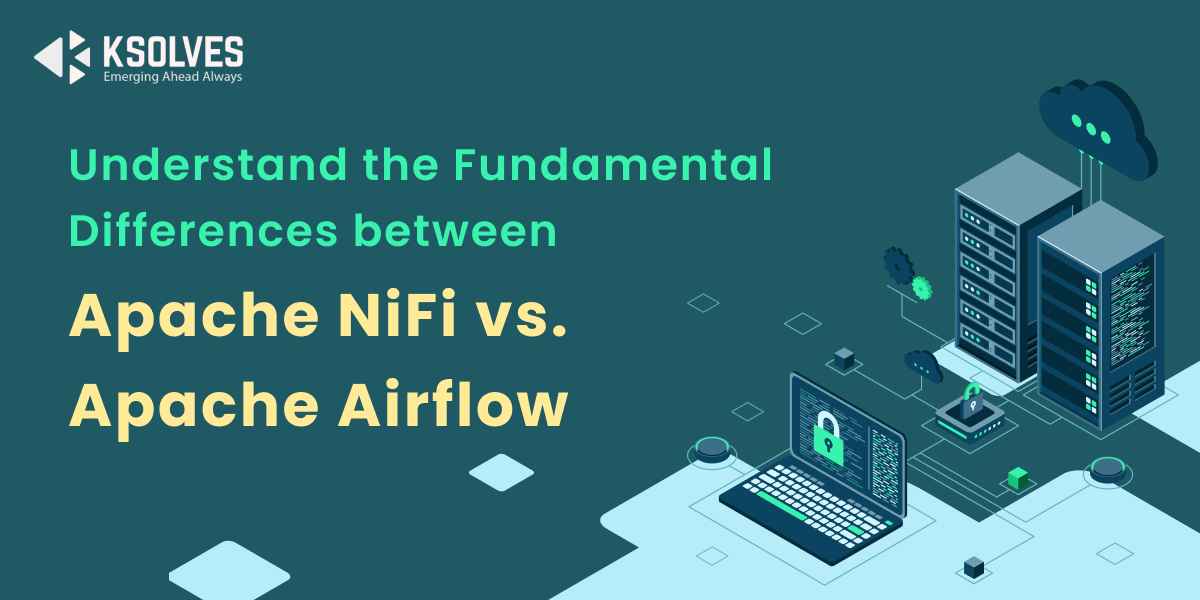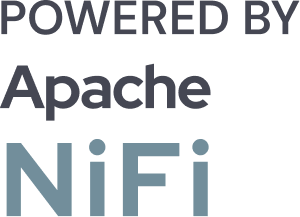Apache NiFi vs Airflow: Choosing the Right Tool for ETL and Data Orchestration
![]()

In the modern data ecosystem, the ability to automate, orchestrate, and scale workflows is crucial for efficient data processing and system reliability. Among the most widely adopted tools in this space are Apache NiFi and Apache Airflow.
Both are open-source platforms that serve distinct but occasionally overlapping purposes in the data pipeline lifecycle. Apache NiFi is engineered for real-time, event-driven data flow automation, whereas Airflow is designed for task-based orchestration and scheduled execution of batch jobs.
In this blog, we offer a comprehensive comparison of Apache Airflow vs NiFi, from architectural overviews and shared capabilities to key differences.
An Overview of Apache NiFi
Apache NiFi is a powerful, flexible data integration and workflow automation platform built for data movement, transformation, and system interoperability. Initially developed by the NSA under the project name “NiagaraFiles”, it was later contributed to the Apache Software Foundation.
Today, NiFi has evolved into one of the most widely adopted tools for building real-time and event-driven data pipelines. What sets NiFi apart is its flow-based programming model. This enables users to design and manage data pipelines through a visual, drag-and-drop interface – no code required.
Key Features of Apache NiFi
- Visual Flow Designer: A browser-based UI allows engineers to build, monitor, and modify data flows with minimal friction.
- FlowFile-Based Architecture: Every piece of data is wrapped in a FlowFile, carrying both content and metadata, enabling granular control and tracking.
- Back Pressure & Prioritization: Built-in flow control mechanisms prevent overload and allow prioritization of critical data.
- Data Provenance: Comprehensive lineage tracking at the record level ensures full traceability, auditability, and debugging capabilities.
- Supports Both Streaming and Batch: NiFi seamlessly handles high-throughput streaming data, as well as scheduled batch operations.
- Extensive Processor Library: Offers hundreds of prebuilt processors for integration with systems like Kafka, S3, HDFS, databases, REST APIs, and more.
What is Apache NiFi Used For?
Apache NiFi is primarily used for real-time data ingestion, transformation, and delivery across diverse systems. It excels at automating data movement between sources like databases, cloud storage, APIs, message queues, and file systems. Common use cases include:
- Streaming data integration (e.g., IoT, Kafka)
- Real-time ETL and data routing
- Data lake and warehouse ingestion
- System-to-system data mediation
- Secure and traceable data flow management
An Overview of Apache Airflow
Apache Airflow is a leading open-source workflow orchestration platform designed to programmatically author, schedule, and monitor data pipelines. Originally developed by Airbnb to manage complex internal workflows, Airflow was later contributed to the Apache Software Foundation. Since then, it has become the de facto standard for task orchestration in batch data processing environments.
At the core of Airflow is its DAG (Directed Acyclic Graph) model, which defines the logical relationships and execution order of tasks. This model provides engineers with complete control over pipeline structure, dependencies, and failure handling.
Key Features of Apache Airflow
- DAG-Based Architecture: Pipelines are structured as DAGs, enabling precise definition of task dependencies and execution order.
- Python-First Design: Workflows are written as Python scripts, offering full programmability, modularity, and integration with version control systems.
- Extensible Operator Framework: Supports a wide range of prebuilt and custom operators for SQL, Bash, Docker, Kubernetes, Spark, REST APIs, and more.
- Schedule-Driven Execution: Pipelines can be triggered based on cron-like schedules or external events, ideal for periodic batch workloads.
- Built-in Monitoring & Alerting: Includes web UI, detailed logs, metrics, and integration with alerting tools for operational visibility.
- Retry & Failure Management: Built-in mechanisms for task retries, error propagation, SLAs, and conditional logic.
What is Apache Airflow Used For?
Apache Airflow is used for scheduling, orchestrating, and monitoring complex workflows, especially in batch data processing environments. Engineers use Airflow to manage interdependent tasks that need to run in a specific order and time. Common use cases include:
- Daily or hourly ETL jobs
- Data warehouse transformation pipelines
- Machine learning model training and deployment
- Report generation and analytics workflows
- CI/CD automation for data applications
Apache NiFi vs Airflow – Similarities
Although NiFi and Airflow serve different purposes within the data engineering ecosystem, they share several foundational attributes that make them powerful and complementary tools:
1. Open Source & Highly Extensible
Both tools are open-source projects under the Apache Foundation with active community support. They offer plugin-based architectures – NiFi through custom processors and controller services, and Airflow through operators, sensors, and hooks.
2. Workflow Orchestration Capabilities
Each platform enables workflow orchestration, though through distinct paradigms:
- NiFi orchestrates dataflows visually using processors and connections.
- Airflow orchestrates task execution via Python-defined DAGs (Directed Acyclic Graphs).
Both support complex logic, dependencies, and conditional execution paths.
3. Integration with Ecosystems
Another similarity between NiFi and Airflow is that they provide native or extensible connectors to a wide variety of systems including:
- Cloud platforms (AWS, GCP, Azure)
- Relational and NoSQL databases
- File systems (HDFS, S3)
- Messaging systems (Kafka, RabbitMQ)
- APIs and RESTful services
4. Scalability and High Availability
Both platforms support horizontal scaling:
- NiFi can run as a clustered data flow engine with load-balanced processing.
- Airflow can scale its workers using Celery, KubernetesExecutor, or other distributed executors.
Each can be configured for high availability in enterprise-grade deployments.
5. Monitoring, Logging, and Observability
NiFi and Airflow provide built-in dashboards for tracking execution status, history, and system health.
- NiFi offers granular data provenance tracking and real-time flow metrics.
- Airflow provides task-level logging, SLA monitoring, retry alerts, and integration with Prometheus, Grafana, or other observability tools.
Apache NiFi vs Airflow – Key Differences
Although Apache NiFi and Airflow both support workflow orchestration, they are built on fundamentally different architectures and serve distinct operational goals. Here’s a detailed breakdown of their core differences between NiFi vs Airflow across critical dimensions:
1. Apache NiFi vs Airflow – Design Paradigm
Apache NiFi: Employs a flow-based programming model with a visual, intuitive interface. Users create data pipelines by connecting processors on a canvas, with drag-and-drop configurability and minimal coding.
Apache Airflow: Follows a code-as-configuration approach. Pipelines are written as Python-defined DAGs, allowing fine-grained control, versioning, and integration with modern DevOps practices.
2. Apache NiFi vs Apache Airflow – Use Cases
Apache NiFi: Optimized for real-time data ingestion, transformation, and delivery across distributed systems. Ideal for moving data between endpoints and applying inline processing.
Apache Airflow: Designed for task orchestration and dependency management, particularly in batch-oriented ETL workflows. Best suited for long-running or scheduled jobs with multiple task dependencies.
3. Apache NiFi vs Airflow – Real-Time vs Batch Processing
Apache NiFi: Natively supports real-time and event-driven streaming pipelines with continuous flow execution. It excels in low-latency use cases.
Apache Airflow: Built for batch processing, triggered by time-based schedules or external events. It lacks native support for streaming data or continuous execution.
4. Apache Airflow vs Apache NiFi – State Management
Apache NiFi: Maintains internal state between processors using FlowFiles, queues, and back pressure. This enables features like guaranteed delivery, replay, and flow control.
Apache Airflow: Is stateless between DAG runs, maintaining only metadata such as task status, execution logs, and parameters in its backend database.
5. Airflow vs NiFi – Deployment and Operations
Apache NiFi: Offers out-of-the-box setup with a web-based UI for deployment, configuration, and flow monitoring. Supports clustering and secure multi-tenant configurations. Moreover, it has got a smarter companion, developed by Ksolves India Limited – Data Flow Manager, which is a centralized, code-free platform to manage the entire lifecycle of NiFi flows (creation, deployment, monitoring, and governance).
Apache Airflow: Requires configuration of multiple components, including the scheduler, web server, metadata database, and executor. More setup-intensive but offers flexibility in distributed deployments (e.g., CeleryExecutor, KubernetesExecutor).
6. Apache NiFi vs Airflow Error Handling and Retry Mechanisms
Apache NiFi: Provides built-in failure routing, queuing, and retry logic per processor. Fault-tolerant by design with configurable backoff and flow redirection.
Apache Airflow: Offers task-level retry settings via DAG definitions. Supports exponential backoff, alerting, and failure callbacks, but lacks dynamic redirection of failed data.
Apache NiFi vs Apache Airflow Comparison
| Feature | Apache NiFi | Apache Airflow |
| Primary Use Case | Data flow automation and real-time ingestion | Batch job orchestration and scheduling |
| User Interface | GUI-based drag-and-drop flow editor | Code-based DAGs defined in Python |
| Execution Model | Continuous flow execution | Triggered/scheduled task execution |
| Real-Time Support | Yes | Limited, not built for real-time |
| Error Handling | Built-in with routing options | Retry logic and failure callbacks |
| Data Provenance | Full support with lineage and audit trails | Limited to task execution metadata |
| Backpressure Support | Yes | No |
| Custom Scripting | Limited to built-in scripting processors | Full Python support |
| Deployment Complexity | Low | Medium to High |
| Best For | Data ingestion, transformation, routing | Task orchestration, scheduling, complex DAGs |
Apache NiFi vs Airflow – Choosing the Right Tool for Data Pipelines
When to Choose Apache NiFi?
- You need real-time data ingestion and delivery.
- You’re working with diverse data sources and need rapid connectivity.
- Visual design and low-code environments are preferred.
- You require data-level monitoring and provenance tracking.
- You need to apply flow control, backpressure, and queuing.
When to Choose Apache Airflow?
- You need to schedule complex task dependencies and execution windows.
- Your pipeline consists of batch workloads (e.g., nightly ETL).
- You want to define workflows using code for version control and testing.
- You’re running multi-step machine learning pipelines or report generation jobs.
- You need integration with Kubernetes, Spark, or cloud-native services.
Conclusion
This was all about Apache NiFi vs Airflow. Both tools serve complementary roles in the modern data stack. NiFi excels at streaming data movement and transformation, while Airflow shines in task orchestration and batch scheduling.
For many organizations, the right approach isn’t choosing one over the other, but rather, integrating both. Use NiFi to collect and transform data in real-time, then trigger Airflow to schedule batch processing, analytics, or ML pipelines downstream.
Understanding the strengths, limitations, and use cases of each can help data engineers and DevOps professionals build more reliable, scalable, and observable data workflows.
FAQs
- Is NiFi better than Airflow?
When comparing NiFi vs Airflow, it depends on the use case. Apache NiFi is better suited for real-time data ingestion, transformation, and routing, especially when you need low-latency, event-driven pipelines. Apache Airflow is ideal for batch job orchestration and complex task scheduling.
- Is Apache NiFi an ETL tool?
Yes, Apache NiFi can act as an ETL (Extract, Transform, Load) tool, particularly for real-time and event-driven pipelines.
- Is Apache Airflow used for ETL?
Yes. Apache Airflow is commonly used to orchestrate ETL workflows, especially in batch processing scenarios.
- What is the difference between NiFi and Airbyte?
Apache NiFi is a general-purpose data integration and flow automation tool, whereas Airbyte is a modern ELT platform focused on data ingestion into warehouses using prebuilt connectors. Airbyte is often used for warehouse-centric ingestion, while NiFi handles more complex routing and streaming pipelines.
- What are the disadvantages of NiFi?
Some key limitations of Apache NiFi include:
- Not ideal for complex task orchestration or conditional logic across unrelated jobs.
- Limited support for version control and CI/CD workflows compared to Airflow.
- High memory consumption for large flows or complex processors.
- Less effective for pure batch scheduling or long-running compute tasks.
- When not to use NiFi?
Avoid using Apache NiFi when:
- Your workflow requires complex task dependencies and branching logic.
- You need cron-based scheduling or time-triggered executions.
- The pipeline is primarily code-centric or ML-model driven.
- Can NiFi replace Kafka?
No, Apache NiFi cannot replace Apache Kafka. Kafka is a high-throughput distributed messaging system, while NiFi is a data flow management tool. However, NiFi can integrate with Kafka, acting as a producer or consumer for Kafka topics.
- What is the difference between Airflow and Airbyte?
Apache Airflow is a workflow orchestration platform used to schedule and monitor batch processes, while Airbyte is a data integration platform focused on ELT into warehouses.

